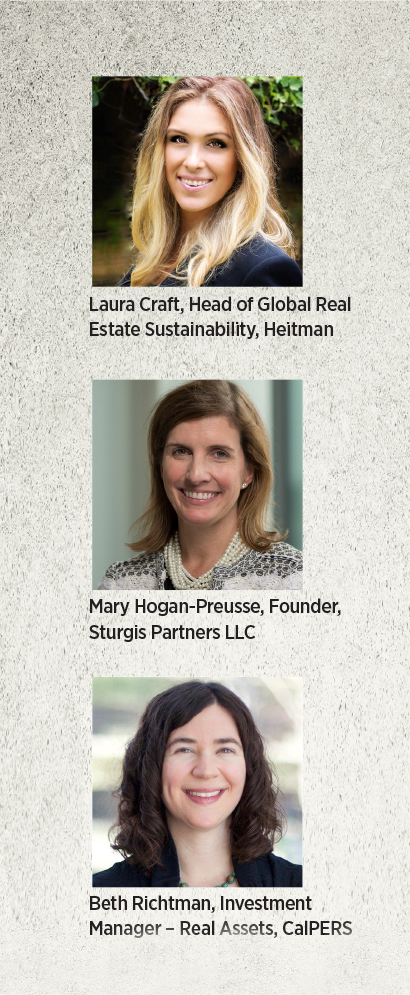Sustainability Issues Are Important to Real Estate Investors
 Talk to executives at REITs and publicly traded real estate companies and they’ll attest that investors want to know more about sustainability. The people who decide how major funds make their real estate allocations are inquiring about everything from energy usage to employee diversity to wellness programs.
Talk to executives at REITs and publicly traded real estate companies and they’ll attest that investors want to know more about sustainability. The people who decide how major funds make their real estate allocations are inquiring about everything from energy usage to employee diversity to wellness programs.
REIT magazine spoke with the heads of three institutional funds for input on how environmental, social and governance issues impact their investment decisions.
REIT: How does ESG play a role in your investment decisions, if at all?
Mary Hogan-Preusse: I believe that ESG considerations are an essential component of the investing picture. I believe that talented management is a strong determinant of a stock’s long-term success, and I find that the best management teams do focus on ESG considerations because it’s the right thing to do.
Laura Craft: We value a REIT’s underlying real estate portfolio, and then we assess the REIT as an enterprise. On the portfolio valuation, we recognize that ESG projects can affect a REIT’s cash flow, as they result in higher revenue or lower operating expenses. The REIT enterprise is also valued, taking into account the enterprise’s management and ESG activities; discounts or premiums are applied to determine the value of the REIT.
ESG is a consideration for all of our investments, whether we first identify a REIT with a strong sustainability program or whether we identify a potential investment and then consider its sustainability program.
Beth Richtman: CalPERS’ real assets program has a set of sustainable investments practice guidelines. They form our approach to identifying, monitoring and managing ESG-related risks that may impact the performance of the investments.
When we consider investing in a real estate manager, we study their policies and practices. We factor those into a score we give managers.
At the asset level, we’ve developed a proprietary ESG consideration matrix that our real estate managers will be asked to use when underwriting real estate assets for CalPERS’ portfolio. This tool includes factors like climate change, resource scarcity, water risk, biodiversity, wellness. The goal is to ensure that these types of ESG factors are thought about before we buy an asset and that the costs and opportunities related to those ESG factors are baked into the financial model.
REIT: Which elements within ESG are you focused on for a company? Do some carry more weight than others?
Richtman: They may vary by asset type and location. In some areas, climate change risk is going to be more important to focus on than in other areas.
Energy efficiency is often low-hanging fruit with quite positive returns. We’re in year one of an energy-optimization initiative, through which we’re looking for opportunities in our assets related to energy demand, use and production. Overall, we want to know that the companies and managers underwriting the assets are identifying the relevant material risks and opportunities and factoring them into their asset selection and business strategy.
We want to be invested with managers and companies that are responding to tenant markets that increasingly demand or expect sustainability.
Hogan-Preusse: I focus on all of them. I think about the “E,” the environmental component, in a couple of different ways. I expect a larger company with core-type assets to demonstrate a commitment to sustainability. I believe that for these companies, their size and scale makes the process of demonstrating sustainability metrics easier than for smaller companies, and in many instances I think that their target tenants demand some evidence of a commitment to sustainability from their landlords.
For smaller companies, I do understand that it may be difficult to provide evidence of industry standard measurements, but I expect them to be able to have the conversation and demonstrate in other ways their commitment to environmental stability.
Craft: Governance issues are the most relevant to REITs and have the greatest impact on our valuations.
As shareholders, we are part owners of the firm and we need to understand how management teams and boards have structured the company to ensure alignment of interests with us. Furthermore, high governance ratings could link to leadership on environmental and social factors.
Beyond the REIT enterprise, environmental activities in the underlying real estate portfolio are also a focus to understand if environmental opportunities have been identified and implemented.
REIT: What about social and governance factors?
Hogan-Preusse: Since I focus on REITs and public real estate companies, there is an element of self-selection. Many social concerns seen in other industries (weapons, land mines, animal welfare) generally do not apply. Social metrics that I examine include ethical issues such as diversity—inclusivity, really—at the corporate and board levels and certain labor-related issues.
“G”—governance—I examine issues including the quality of management, the quality and composition of the board, and executive compensation. I think that the relationship between management and boards and between management and employees is an extremely important concern, but one that is hard to measure.
REIT: What data and tools do you use for your analysis?
Hogan-Preusse: Lots of things, including data provided by companies and published by GRESB, company information and proxies, the sustainability section of their web sites (everyone should have these) and management interviews.
Richtman: We’re currently rolling out GRESB across our real assets portfolio – just this year we started asking our real estate managers to fill it out.
For our global equity portfolio which holds our REITs, we are using MSCI’s ESG Manager Tool which provides reports and letter grades for REITs.
Craft: Our own analysts and portfolio managers incorporate ESG analysis as part of their normal research process to identify any ESG-related issues or initiatives that might affect a company’s valuation. We rely on a REIT’s financial filings, augmented by our own primary research conducted by touring properties and meeting with management teams.
Some REITs produce detailed sustainability reports, quantifying what they are doing on the ESG front, backed with data to quantify the cost and impact of ESG efforts. Such disclosure is helpful.
We do subscribe to third-party ESG data sources, which pull in information from various public or private data inputs. However, an overall ESG rating can be confusing and misleading if taken out of context. This is where a company’s sustainability report can become an important avenue for identifying material ESG factors and quantifying ESG activities and impacts.
REIT: Do you think we’re approaching an investing world that identifies consistent methodologies for collecting and analyzing ESG data for decision making?
Hogan-Preusse: Not yet.
Craft: The industry is moving closer to consistent methods but it still has a ways to go. ESG ratings vary in approach, materiality, weighting and comprehensiveness. Additionally, the REITs themselves vary in geographic location, property type, operational control, and portfolio composition. As a result, ESG data sets need to be taken in context.
Richtman: I think the industry has come a long way in terms of terms tracking and reporting. However, I imagine that sustainability officers at REITs must be somewhat overwhelmed by as many surveys as they currently have to fill out; over time hopefully reporting requirements can be streamlined to be useful to investors, consistent and not overly burdensome.
One particular area that I hope improves is climate risk to assets. I don’t think there’s currently a great tool for investors yet. My dream tool would be a ZIP code scenario analysis showing the physical risk, resiliency of the surrounding infrastructure, and estimating climate change related tax and insurance risks for a particular asset or portfolio.
REIT: How does sustainability impact your fundraising efforts?
Craft: The frequency of investor questions about how we incorporate ESG into our investment process is increasing. Right now, investors are most interested in knowing that we are monitoring ESG efforts and impacts as part of our valuation process, rather than specifying ESG-related terms or fund attributes.
REIT: Do you see any opportunities for REITs and/or REIT investment managers to help educate source capital in this area?
Craft: Definitely. Investors never want to feel left behind, so as the awareness of ESG continues to grow, opportunities to educate investors on its importance will expand accordingly.
Richtman: One thing that would be useful is to provide data and participate in studies about what ESG practices are economically beneficial. It’s great as an investor to read about greenhouse gas reductions or decreased energy use, but it gets a little bit more exciting when we learn about how much money was saved or how it might improve the type of returns.
Kilroy Realty Corp. (NYSE: KRC) uses SASB’s standards in its 10-K, which is a great example of a REIT educating the market. It elevated their sustainability efforts by showing they’re material to their business.
Hogan-Preusse: I think NAREIT has done an excellent job of publicizing and monitoring this issue through its Leader in the Light program. The GRESB survey provides a helpful yardstick for comparing companies, which will only get better over time as the survey is further refined and we have more years of data to compare.
Because the public real estate industry is so transparent and was a relatively early adopter of ESG initiatives, I think that a REIT fund whose investments all demonstrate strong commitments and performance on ESG initiatives and metrics would be a welcome investment choice for pension funds and other socially responsible investors.
REIT: What can REITs do better to improve the quality of their ESG data?
Craft: REITs need to set clear boundaries on the areas that they can and can’t control. REITs can understand their portfolio exposure and annual average loss (AAL) ascribed from insurance on their geographic environmental risks, quantify the percentage of the portfolio that they have operation control over and pay utilities on, report on the sustainability ROI projects, highlight innovative technologies and practices, and give insight into activities taken that increase occupier retention.
 REITs have limited control over occupant behavior and operations and usage of their rented space, including utility consumption. In many cases, REITs will not have access to occupants’ utility information, as occupants will pay utility companies directly for their usage. REITs should not spend considerable amounts of time tracking data that they do not control and pay the bills for; REITs should focus time and efforts on controllable data and operations.
REITs have limited control over occupant behavior and operations and usage of their rented space, including utility consumption. In many cases, REITs will not have access to occupants’ utility information, as occupants will pay utility companies directly for their usage. REITs should not spend considerable amounts of time tracking data that they do not control and pay the bills for; REITs should focus time and efforts on controllable data and operations.
Richtman: It’s helpful to not only get a snapshot of where a company is today, but also where it’s going. How are they looking at risks and opportunities related to ESG? Most importantly, what are they doing about them?
REIT: What do you recommend for REITs that are just starting a sustainability program or trying to revamp their strategy?
Richtman: Research what other real estate managers are doing. I’d consider hiring a consultant or staff with expertise in this area.
Hogan-Preusse: My best advice is also one of my favorite sayings: “Do not let the perfect be the enemy of the good.” I know that extensive surveys like GRESB can be daunting for smaller companies. Additionally, many companies are not ready to make the commitment to check every box in terms of what it takes to achieve best-in-class social and governance standards.
Something is better than nothing. Post something on your website demonstrating your commitment to sustainability in smaller ways, from recycling to development standards to environmentally friendly transportation opportunities.
Even if you “can’t find the right people to improve diversity at your organization,” why don’t you focus on finding just one? Trust me, you can find one person. Even better, how about establishing a mentoring or training program to create future leaders who will fulfill these criteria?
Address governance concerns that investors are posing to you head on, and be as transparent as possible.
Craft: Focus on improving the ESG factors and initiatives that will improve portfolio performance and publicly disclose sustainability efforts and projects with quantifiable numbers.
Public disclosure will help in the passive ESG ratings and in valuing a REIT. As an REIT investor, we are always trying to derive a better valuation for each company, so the more companies can disclose on ESG issues the better.
Published at Wed, 26 Jul 2017 15:26:28 +0000


